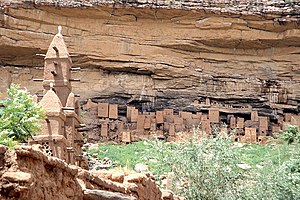

The Tellem (meaning: "those who were before us" or "We found them" in the Dogon language[1][2]) were the people who inhabited the Bandiagara Escarpment in Mali between the 11th and 16th centuries CE.[3][4] The Dogon people migrated to the escarpment region around the 14th century. In the rock cells of this red cliff, clay constructions shelter the bones of the Tellem as well as vestiges witnessing to their civilization, which existed well before that of the Dogons.
- ^ Bedaux, Rogier M. A., Tellem, reconnaissance archéologique d'une culture de l'Ouest africain au Moyen Age : recherches architectoniques, Journal de la Société des Africanistes, V. 42, 1972 , p. 61 (PDF) [1]
- ^ Huib Blom, Dogon, huib blom (2010), p. 24, ISBN 9782839907255 [2]
- ^ Tarlow, Sarah; Stutz, Liv Nilsson; The Oxford Handbook of the Archaeology of Death and Burial (Oxford Handbooks in Archaeology), OUP Oxford (2013), p. 214, ISBN 9780199569069 (retrieved March 15, 2020) [3]
- ^ "Girdle [Mali; Tellem peoples] (1998.478.4,5) | Heilbrunn Timeline of Art History | The Metropolitan Museum of Art". www.metmuseum.org. Archived from the original on 2010-05-15.
